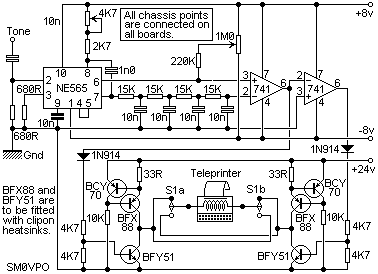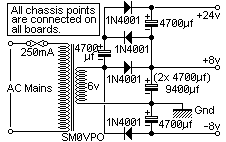


This circuit may be connected directly across your rig speaker terminal and used to drive a teleprinter coil directly. A normal teleprinter coil requires 80/80 volts to energise the coil, but this is connected in series with a 2.7K resistor to give a sort of constant current. The teleprinter coil never has more than 20 volts accross it, so we can use semiconductors to limit the current with a supply voltage of less than 30 volts. With no signal, adjust the 4K7 potentiometer for a frequency of 1360 Hz at pins 4/5 of the NE565. Set the 1M0 pot so that the teleprinter just stops 'racing' or 'marking' (continuously going Chunk-Chunk-Chunk-Chu...). The teleprinter switch S1 reverses the sensitivity of the decoder. Some operators used to send the tones backwards (or perhaps I always sent my tones backwards!!).
The output of the two OpAmps may be used to feed a computer, each OpAmp gives the received RTTY signal in the opposite phase. The output of an OpAmp is 8v reversals that can be used to feed an RS232 input. It may be simply modified to provide a TTL output if desired (clip to +ve only with diode and attenuate to 5v).
The encoder may be a simple two transistor multivibrator. If polystyrene capacitors are used then the frequency stability will be more than adequate, even without a regulated supply.

To align, short the teleprinter keyboard input terminals and adjust the RIGHT-HAND 4K7 pot for an output frequency of 1275 Hz. Open circuit the teleprinter keyboard input terminals and adjust the LEFT-HAND 4K7 pot for an output frequency of 1445 Hz. The teleprinter keyboard contacts should normally be short circuit. Connect the output to the microphone socket of your rig.
The whole terminal unit is powered from a -8v, +8v and +24v. All these voltages can be obtained from a single 6v transformer.

This circuit is very simple and needs no further explanation.
In operation, I always had the decoder driving the printer and the keyboard encoded. During transmit I looped the output of the encoder to the decoder to give me a local copy. The same switch also placed a ground on the transciever PTT line. Interestingly, if the loop has not been made then the TU will both send and receive simultaneously. When I lived in Cambridge UK I used the local DATA/RTTY repeater GB3PT. With a duplex TX/RX radio and this TU I was able to actually see on the printer what I had sent via the repeater (Does RTTY talk-through = read-through??).
About 60 of these units have been built by myself as I used to sell them (but not now) to radio amateurs in the Cambridge UK district. I hope that you have as much fun with this circuit as I have. I used to send hundreds of pictures accross the country and even on HF after I got my G4VVJ ticket.
Dont forget to visit my messageboard if you have any questions about this or any other project. I always look forward to receiving feedback, positive or negative. You do not have to register to post messages.
Very best regards from Harry Lythall
SM0VPO (QRA = JO89WO), Märsta, Sweden.
EA/SM0VPO (QRA = IM86BS), Nerja, Spain.